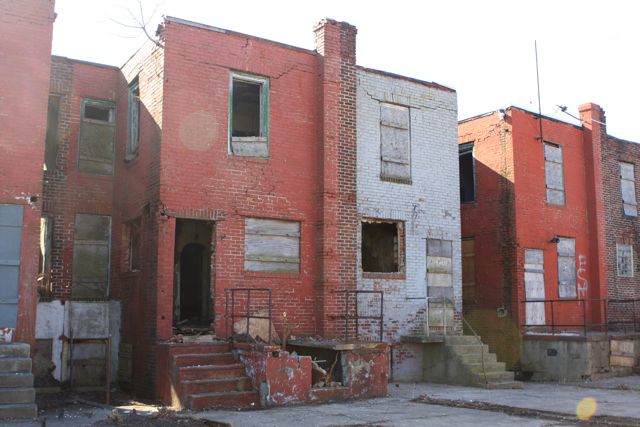Gov. Christie Looks To Johns Hopkins Gentrification of Baltimore as Model For Camden
Rowan’s Eminent Domain Powers Exceed Even Johns Hopkins’ Dominance Over Baltimore Neighborhoods
“Public – Private Partnership” a Slogan for Patronage and Profits
Christie – Norcross – Sweeney Machine on Steroids
If you want to understand the apparent confusion over Gov. Christie’s approval of legislation (P.L. 2013, c. 227) to give Rowan University eminent domain powers to create “public – private partnerships” in Camden, look to how Johns Hopkins has behaved in Baltimore.
There is nothing that suggests “partnership” in any of that – unless the partners you are referring to are real estate investment and corporate development partners.
For a discussion of the community’s perspective on what has transpired in Baltimore, watch this superb four part series at Real News Network (part 3 is especially good: Gentrification of Baltimore’s Middle East)
JAY: We’re continuing our discussion about Middle East, Baltimore. It’s an area of Baltimore just to the north of Johns Hopkins Hospital, where thousands of people used to live. Many have been forcibly removed by use of eminent domain, the city law, to force people out of their houses so Hopkins can expand. And it’s one sample or example of the problem of boarded-up and vacant housing in Baltimore. […]
GOMEZ: When it gets into that walled-off space that we think is for the privileged and protects the privileged, then we have to keep expanding our walls, I think, which is something that Hopkins has done over the years. It’s expanded its walls to continue to keep itself feeling safe, its community to feel safe.
So when Martin O’Malley, then mayor, announced this plan, he said this was the city’s plan. He said, and he was quoted as saying, yes, it involves Hopkins expansion, but the city’s taking the lead on this. It was such an example of public-private partnership, one–the biggest one you’ve probably–we’ve ever seen in Baltimore, where the city government would take the lead on facilitating a private expansion, not only in making sure to acquire land through government law, but also to provide subsidy for a $1.8 billion project–now over $500 million spent to date, 12 years in.
JAY: This is where they created East Baltimore Development Incorporated, with about, what, $1.8 billion to–public money, some foundation money, some Hopkins money.
GOMEZ: Exactly, $1.8 billion to facilitate this expansion into this 88 acre area. Of the $500 million spent to date, almost half is public subsidy in some form of grant, tax subsidy, tax increment financing, to help the developer expand. So it’s been–I think we have to really keep sight of the fact that this is a public-private partnership that is fully invested in helping this private entity gain more power and more access to resources.
And this EBDI, East Baltimore Development Incorporated, which is the proxy for this development, it’s a public-private organization which doesn’t allow us, as the public, to access its records because it’s still private. […]
GOMEZ: I think it’s true that the neighborhoods are and were abandoned and disinvested. I think also if you speak to residents, they will say it’s not that we don’t want reinvestment, it’s not that we don’t want rebuilding, but we want to be a part of it. This plan never intended for residents to participate, to be a part of it. This plan was one for them to be removed so that their land, the land they lived in, the land they called community, would be used for something that others felt had better purposes than for those people who were there. So it’s not that residents didn’t want for their land or for the community to change; it’s just that they wanted to participate and they wanted to have the decision whether or not they wanted to stay in that community. That was never a part of this deal.
Like Camden, portions of Baltimore are poor, black, and abandoned by both the private and public sectors – places that Chris Hedges has called capitalisms’ “sacrifice zones” (Watch Bill Moyers interview with Chris Hedges ).
In Baltimore, Johns Hopkins is behaving like a feudal Lord, hell bent on a racist socio-economic cleansing mission.
Now, Governor Christie – and his Norcross – Sweeney cronies – have empowered Rowan to play that same ugly game in Camden.
No wonder the Governor denied any knowledge of even signing such a bill, see:
- Christie Grants Eminent Domain, Doesn’t Realize It
- Christie seemed unaware he signed Camden eminent domain bill
The WNYC story captured the political strategy:
But the new law is rooted in one of Christie’s first term accomplishments — restructuring higher education — that came about because of a partnership with Democrats, not Republicans. The restructuring was pushed by George E. Norcross III, the unelected South Jersey Democratic leader who is the chairman of Cooper University Hospital in Camden. That hospital has a new medical school with Rowan University and directly benefits from both the restructuring and the new eminent domain law.
The bill was rushed through by Norcross ally Stephen Sweeney, the state Senate President and a South Jersey Democrat who has worked extensively with the governor. The quick bill signing indicates that — despite the George Washington Bridge investigation led by Democrats in the Legislature — the alliance between Christie and Sweeney is still very much alive. That suggests Christie may continue to be able to govern despite the bridge scandal and the Sandy funding shakedown allegations plaguing his administration.
But, the “public – private partnership” real estate development strategy story has not been told.
Time for some property records research in Camden!
And the story about the community destruction and gentrification that is sure to follow that profit driven corporate development strategy has yet to be told as well.
Calling all intrepid reporters!
Next: we link Christie Camden strategy with events in Newark – see below screen shot to suggest the narrative for that:

